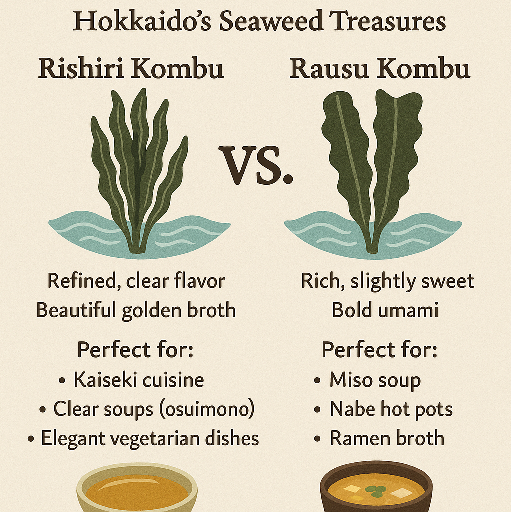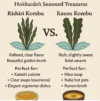
When it comes to Japanese cuisine, dashi—umami-rich soup stock—is the invisible foundation that makes everything sing. At the heart of the best dashi lies an unassuming yet powerful ingredient: kombu (kelp). And in Japan, no kombu is more celebrated than that which comes from the cold, clean waters of Hokkaido.
Among the finest varieties are Rishiri Kombu and Rausu Kombu, two kelps harvested from opposite coasts of the northern island. Though they share a similar heritage, they are surprisingly different—each with its own personality, culinary role, and fanbase.
🌊 Rishiri Kombu – The Elegant Northern Star
Harvested near Rishiri Island, off the northwest coast of Hokkaido, Rishiri kombu is known for its refined, clear flavor and beautiful golden broth. It has been the favored choice of Kyoto’s kaiseki chefs for centuries, thanks to its subtle aroma and long-lasting umami.
Rishiri kombu has a firm texture and requires a slightly longer soaking time to release its full flavor. But the payoff is worth it: a delicate yet deep stock that enhances traditional dishes without overpowering them.
Perfect for:
- Kaiseki cuisine
- Clear soups (osuimono)
- Elegant vegetarian dishes
🔥 Rausu Kombu – The Bold Umami King
On the eastern side of Hokkaido, near the rugged Rausu coast, grows a different kind of kombu. Rausu kombu is darker in color and produces a rich, slightly sweet broth with a bold, lingering umami. Unlike the more restrained Rishiri variety, Rausu kombu makes its presence known.
Its soft texture makes it easier to extract flavor, even with shorter cooking times. It’s the go-to kombu for hearty dishes and miso-based soups, and it’s beloved by home cooks and professional chefs alike.
Perfect for:
- Miso soup
- Nabe hot pots
- Ramen broth
🥢 Which Kombu Is for You?
Think of Rishiri kombu as a violin in a chamber orchestra, and Rausu kombu as a cello in a jazz band. Both are exquisite, but they play different roles.
If you ever travel to Hokkaido, seek out these kelps in local markets—or better yet, try dishes prepared with them at traditional restaurants. You’ll begin to understand why kombu isn’t just a seasoning ingredient in Japan—it’s part of a culinary philosophy.
出汁の戦い:利尻昆布 vs. 羅臼昆布 ― 北海道の海藻の宝物たち
日本料理において、出汁(だし)は、すべての料理を引き立てる見えない基礎です。そして、最高の出汁の中心には、目立たないけれども力強い材料が存在します。それが昆布です。日本において、北海道の冷たく清らかな海で採れる昆布ほど高く評価されているものはありません。
中でも最高級とされているのが、利尻昆布と羅臼昆布です。この2つの昆布は、北海道の反対側の海岸で収穫され、それぞれが異なる個性、料理での役割、そしてファンを持っています。
🌊 利尻昆布 ― 上品な北の星
北海道の北西部、利尻島近海で採れる利尻昆布は、洗練された澄んだ味と美しい黄金色の出汁で知られています。控えめな香りと長く続く旨味のおかげで、京都の懐石料理の料理人たちに何世紀にもわたって愛されてきました。
利尻昆布はしっかりとした質感を持ち、うま味を引き出すにはやや長めの水出し時間が必要です。しかし、その見返りは十分あります。伝統的な料理を引き立てながらも、決して主張しすぎない、繊細で深みのある出汁がとれます。
おすすめの用途:
- 懐石料理
- お吸い物
- 上品な精進料理
🔥 羅臼昆布 ― 濃厚旨味の王様
北海道の東側、険しい羅臼の海岸近くでは、まったく異なるタイプの昆布が育ちます。羅臼昆布は色が濃く、濃厚でほんのり甘みのある出汁を生み出し、はっきりとした、余韻のある旨味を持っています。より控えめな利尻昆布とは対照的に、羅臼昆布はその存在感をはっきりと示します。
柔らかい質感のため、比較的短い調理時間でもうま味を引き出すことができます。味の濃い料理や味噌を使ったスープに最適で、家庭の料理人からプロの料理人まで幅広く支持されています。
おすすめの用途:
- 味噌汁
- 鍋料理
- ラーメンのスープ
🥢 あなたにぴったりの昆布はどっち?
利尻昆布は、室内楽のバイオリンのような存在。羅臼昆布は、ジャズバンドのチェロのようです。どちらも優れていますが、その役割は異なります。
北海道を訪れる機会があれば、ぜひ地元の市場でこれらの昆布を探してみてください。あるいは、昆布を使った料理を提供する伝統的な料理店で味わってみましょう。そうすれば、昆布が単なる調味料ではなく、日本の料理哲学の一部であることが理解できるはずです。
